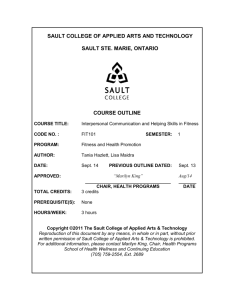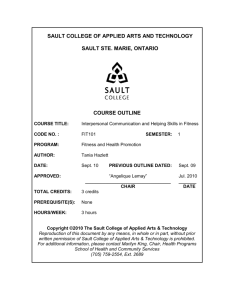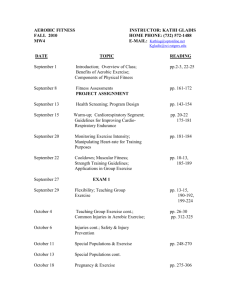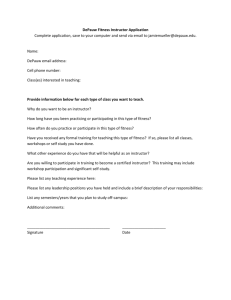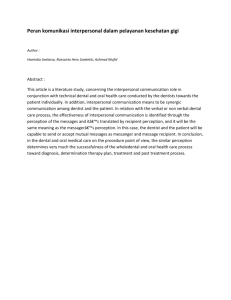Interpersonal Communication Helping Skills in
advertisement
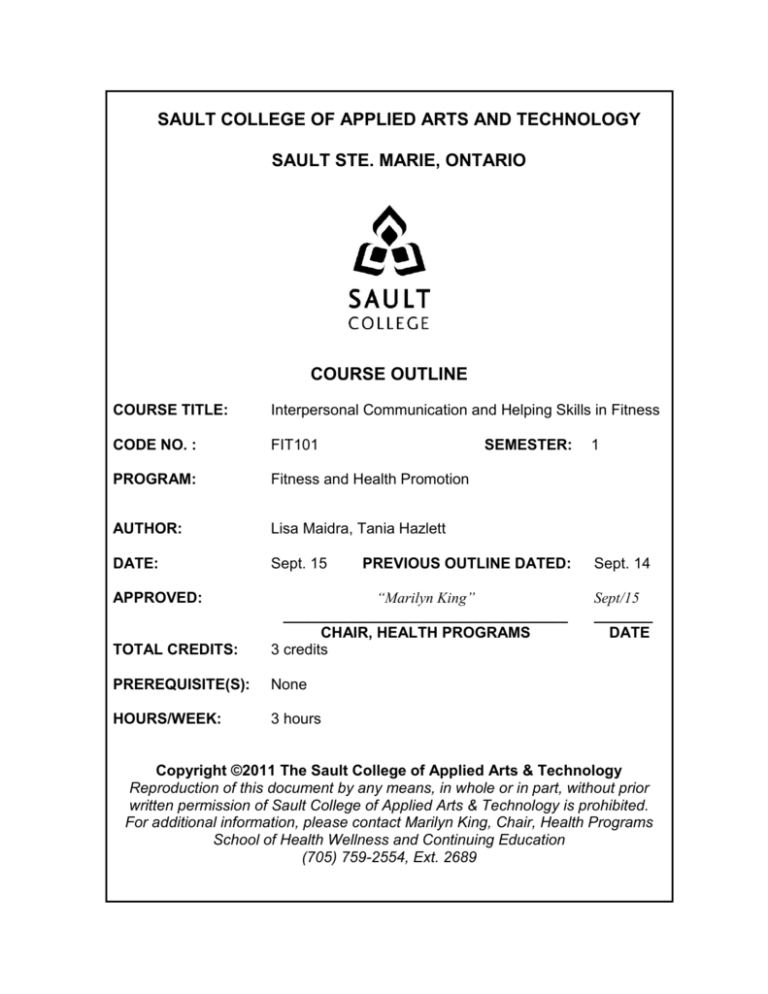
SAULT COLLEGE OF APPLIED ARTS AND TECHNOLOGY SAULT STE. MARIE, ONTARIO COURSE OUTLINE COURSE TITLE: Interpersonal Communication and Helping Skills in Fitness CODE NO. : FIT101 PROGRAM: Fitness and Health Promotion AUTHOR: Lisa Maidra, Tania Hazlett DATE: Sept. 15 PREVIOUS OUTLINE DATED: Sept. 14 APPROVED: Sept/15 _______ DATE TOTAL CREDITS: “Marilyn King” __________________________________ CHAIR, HEALTH PROGRAMS 3 credits PREREQUISITE(S): None HOURS/WEEK: 3 hours SEMESTER: 1 Copyright ©2011 The Sault College of Applied Arts & Technology Reproduction of this document by any means, in whole or in part, without prior written permission of Sault College of Applied Arts & Technology is prohibited. For additional information, please contact Marilyn King, Chair, Health Programs School of Health Wellness and Continuing Education (705) 759-2554, Ext. 2689 Interpersonal Communication and Helping Skills in Fitness I. 2 FIT101 COURSE DESCRIPTION: In this course students will learn the interpersonal communication skills necessary to become effective communicators in the fitness and health promotion fields. Students will develop the skills required to be effective when helping individuals to make healthy lifestyle changes. Students will also develop motivational techniques to increase client adherence. Effective interviewing will also be practiced and applied to appropriate workplace scenarios. The helping relationship and qualities that enhance this relationship will be discussed and practiced. II. LEARNING OUTCOMES AND ELEMENTS OF THE PERFORMANCE: In general, this course addresses Vocational Learning Outcomes (crossreferenced with the Program Standards) in: assessment, development and application skills (1,2,3), communication skills (1,3,4,11), promotion skills (3,7). It addresses the Generic Skills Learning Outcomes 1, 2, 6, 13. Upon successful completion of this course, the student will demonstrate the ability to: 1. Describe factors that influence communication and practice communication techniques to possible client situations. Potential Elements of the Performance: Define the principles of communication Explain the relationship of attitudes, beliefs and values with effective communication Define and explain self-concept and self esteem Define personality and identify the major personality factors and traits Define learning styles and explain the importance to interpersonal communication Identify strategies to deal with different personalities and utilize relevant communication styles appropriate to different personalities and various age groups. Describe perception and the perception process Explain factors that influence perception List barriers to accurate perception List and explain listening styles and barriers Define and explain verbal and non-verbal communication and discuss strategies to improve verbal and non-verbal communication Interpersonal Communication and Helping Skills in Fitness 2. 3 FIT101 Describe and demonstrate effective interviewing skills. Potential Elements of the Performance: Establish rapport and a supportive environment Describe elements of a skilled interview process Conduct an initial interview Critique assigned interviews and reflect on skill improvement Demonstrate ability to communicate openness and attentiveness in a verbal and non-verbal manner Discuss strategies to improve listening and responding skills 3. Discuss effective interpersonal communication skills as they relate to roles in the fitness industry. Potential Elements of the Performance: Explain the process of CSEP-PATH counseling List and explain the styles of counseling and limitations in the fitness industry Explain the Activity Counselling Model Discuss motivational techniques to improve client adherence to a healthy lifestyle Determine the needs, wants, abilities, and limitations of the client for goal setting. Define the principles of customer satisfaction Identify the skills that are necessary to deal with customer dissatisfaction Discuss the advantages and disadvantages of working in teams Explain personal productivity and stress management and their importance in helping professions 4. Demonstrate critical thinking skills through case study and real life evaluation. Potential Elements of the Performance: Participate and reflect on group problem-solving activity Reflect on and integrate information presented in class with experiences in the community 5. Identify and demonstrate qualities of the helping profession that positively influence relationships. Potential Elements of the Performance: Explain the terms empathy, sympathy Define culture and diversity and identify factors that enhance effective communication with varied populations Contrast the attitudes and actions of nurturing and toxic people Explain coaching skills and techniques for helping difficult people Interpersonal Communication and Helping Skills in Fitness 4 FIT101 Integrate the philosophy of wellness/active living through its appropriate application to clients. 6. Potential Elements of the Performance: Define the stages of change for physical activity and apply the content to various client’ lifestyles. Identify and define key leadership and presentation skills that enhance the effectiveness of wellness/active living messaging III. TOPICS 1. Professionalism and Confidentiality 2. Verbal and Nonverbal Communication 3. Personality Differences 4. Self-esteem and Self concept 5. Perception 6. Listening 7. Behaviour Theories 8. Motivational Interviewing 9. Presentation Skills 10. Teamwork 11. Customer Service Skills 12. Employability Skills 13. Personal Productivity 14. Stress Management IV. REQUIRED RESOURCES/TEXTS/MATERIALS: CSEP-PATH: Physical Activity Training for Health V. EVALUATION PROCESS/GRADING SYSTEM: A combination of quizzes and assignments will be used to evaluate student achievement of the course objectives. A description of the evaluation methods follows and will be discussed by the teacher during the first class. (3) Quizzes – 15% (9) Learning Activities – 45% Assignment 1: Interview – 20% Assignment 2: Presentation – 20% Interpersonal Communication and Helping Skills in Fitness 5 FIT101 Note: Missed Tests and Late Assignments If you miss a written test, you must call/email your instructor BEFORE the test to explain your absence. Only medical emergencies and extreme circumstances will warrant the opportunity to write the missed test at a later date. Official supporting documentation, such as a physician’s certificate, may be required as confirmation of your illness. Arrangements with your instructor must be made as soon as you resume attendance at Sault College. Failure to comply with this policy will result in a zero grade for the missed test. Written assignments must be submitted on the date and time specified. If the student is unable to do so, the teacher must be notified 24 hours prior to the due date and time. Failure to request an extension or requesting an extension later than 24 hours prior to the due date, will result in a zero grade for the assignment. For example; if the due date is on September 16, anything submitted after the 16th, will be counted as 0 grade. Similarly, if the assignment is due on September 16th by 5pm, anything submitted after 5pm will be considered late and will receive a 0 grade. Five marks per day of extension (with permission) will be deducted from the assignment for up to three academic days. For example, if an assignment has been granted a three day extension, there will be a five mark penalty each day it is late (total of 15 marks). The request for an extension does not necessarily result in an extension. The final decision to permit an extension resides with the professor. The professor may choose to discuss the situation with the coordinator and/or dean of the program. In the event of extenuating circumstances (ie. death, acute illness, disaster, etc.) where the extension could not be anticipated and which precludes the student from submitting the assignment on the due date an extension will be granted without penalty. The student is obliged to notify the teacher within 24 hours of the due date and collaborate on a date of submission. Appropriate documentation may be requested by the teacher to validate the extenuating circumstances. Please see additional expectations for this course on your course syllabus. Instructor’s Name: Lisa Maidra Instructor’s Phone #: 759-2554, Ext. 2629 Instructor’s email: lisa.maidra@saultcollege.ca Interpersonal Communication and Helping Skills in Fitness 6 FIT101 The following semester grades will be assigned to students: Grade Definition 90 – 100% 80 – 89% 70 - 79% 60 - 69% 50 – 59% 49% and below A+ A B C D F (Fail) CR (Credit) S U X NR W Grade Point Equivalent 4.00 3.00 2.00 1.00 0.00 Credit for diploma requirements has been awarded. Satisfactory achievement in field /clinical placement or non-graded subject area. Unsatisfactory achievement in field/clinical placement or non-graded subject area. A temporary grade limited to situations with extenuating circumstances giving a student additional time to complete the requirements for a course. Grade not reported to Registrar's office. Student has withdrawn from the course without academic penalty. If a faculty member determines that a student is at risk of not being successful in their academic pursuits and has exhausted all strategies available to faculty, student contact information may be confidentially provided to Student Services in an effort to offer even more assistance with options for success. Any student wishing to restrict the sharing of such information should make their wishes known to the coordinator or faculty member. VI. SPECIAL NOTES: Attendance: Sault College is committed to student success. There is a direct correlation between academic performance and class attendance; therefore, for the benefit of all its constituents, all students are encouraged to attend all of their scheduled learning and evaluation sessions. This implies arriving on time and remaining for the duration of the scheduled session. VII. COURSE OUTLINE ADDENDUM: The provisions contained in the addendum located in D2L and on the portal form part of this course outline.
